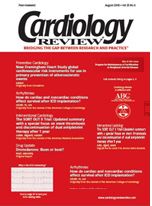Publication
Article
Cardiology Review® Online
ACE inhibition and atrial fibrillation: Improving the substrate
In this issue, Keller and colleagues (page 12) summarize their study of 5,463 hypertensive patients taking angiotensin-converting enzyme (ACE) inhibitors matched with patients taking calcium channel blockers. After a 4-year follow-up, they found a significantly lower rate of new-onset atrial fibrillation in the ACE inhibitor group. There also was a significant reduction in the rate of atrial-fibrillation—related hospitalizations. This finding is consistent with several previous reports, including a substudy of the Studies Of Left Ventricular Dysfunction trial1 and another study, which showed that ACE inhibitors reduced the incidence of atrial fibrillation following acute myocardial infarction (MI).2
The beneficial effects of ACE inhibitors cannot be explained by improvements in hypertension since both groups were being treated for hypertension. The authors imply that there is a direct antiarrhythmic action, although it is also possible that ACE inhibitors prevent the atria from remodeling. Studies have demonstrated that atrial fibrillation can cause changes in the atrial tissue, making it more likely to fibrillate (hence “atrial fibrillation begets atrial fibrillation”).3 ACE inhibitors appear to help prevent this remodeling process. In a study examining the effect of adding ACE inhibitors to antiarrhythmic drug treatments in patients undergoing cardioversion, there was a reduction in the number of admissions for atrial fibrillation, as found in the present study.4 In addition, signal-averaged P-wave duration, a measure of atrial remodeling, was significantly shorter, even after 1 year of treatment with ACE inhibitors. These findings suggest that ACE inhibitors may help to prevent atrial remodeling.
How do we apply these findings to our patients? Many patients with structural heart disease already have an indication for ACE inhibitors. In patients with congestive heart failure and MI, ACE inhibition has been conclusively shown to improve survival. The study by Keller and colleagues tells us that ACE inhibitors may help to prevent atrial fibrillation in patients with hypertension. Thus, ACE inhibitors should be offered in all of these groups.
Should ACE inhibitors be used in patients without structural heart disease (ie, lone atrial fibrillation)? The authors point out the need for a prospective controlled trial. Such a trial would add to our understanding of the role of ACE inhibition in the treatment of lone paroxysmal atrial fibrillation. There are few data
on the use of ACE inhibitors in lone atrial fibrillation. Animal studies suggest that ACE inhibitors may be effective if administered early in the course of atrial fibrillation.5 A recent study demonstrated this in patients with atrial fibrillation treated with antiarrhythmic agents and ACE inhibitors.6 Unfortunately, this study was retrospective and did not examine patients with lone atrial fibrillation. Nonetheless, it adds support to the role of ACE inhibitors in the treatment of atrial fibrillation.
A growing body of literature supports the use of ACE inhibitors in patients with atrial fibrillation. Most patients with structural heart disease already have an indication for treatment with ACE inhibitors. More data are needed to support the use of these agents in patients with lone paroxysmal atrial fibrillation.
